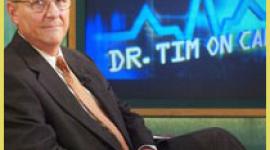Beyond Prozac: New Depression Treatments, New Hope
Welcome to the 21st-century lab, where hormones, brain pacemakers and magnetic coils can treat and cure depression, even treatment-resistant depression.
We've come a long way. Some psychiatrists used to think you could cure depression by removing a patient's colon or teeth. In the late 1800s, there was a doctor who observed his anxious patient become calm on a bumpy train; thereafter treatment consisted of shaking the poor man for greater and greater lengths of time.
In an attempt to cure the ancient malady of melancholia, we have resorted to scads of strategies, some of them plainly stupid or cruel, others, like Prozac (Fluoxetine), that work. But an estimated 30 percent of depressed patients are what's called treatment-resistant; they don't respond to pills or talk or even electroshock therapy. The good news is that there are new treatments for depression making their way into the 21st-century world; depression treatments that offer hope for the newly diagnosed or for someone who has been suffering without, so far, a cure in sight.
The Gold Standard of Treating Depression
We want to urge you to read our special depression treatment section: "The Gold Standard for Treating Depression." It's an in-depth, authoritative examination of the best treatments for depression (covering all aspects of treatment for depression, from getting a correct diagnosis to antidepressant medications, therapy and lifestyle changes.) written by award-winning author, Julie Fast, exclusively for HealthyPlace.com. This section includes depression videos; interviews with Julie Fast.
Miracle Medications for Depression
It used to be that psychiatrists would try a patient on one antidepressant medication, wait eight weeks and, if it didn't work, switch to another one. While this is still a viable (if frustratingly slow) tactic, psychiatrists are relying more and more on secondary, and even tertiary, drugs to boost the primary player. One of those booster drugs is Cytomel, a thyroid stimulator. Even women with normal thyroid levels can, under a psychiatrist's supervision, take Cytomel in addition to an antidepressant. About 50 percent of the time, it helps the primary drug work more effectively. Other popular booster medications are lithium (Eskalith) and Ritalin (Methylphenidate).
Hormone Therapy As A Treatment for Depression
 Scientists have spent years and years investigating chemicals like serotonin and their effects on mood, while neglecting to study brain chemicals still more common, and abundant, like estrogen and progesterone. Andrew Herzog, M.D., a neuroendocrinologist at the Beth Israel Deaconess Medical Center in Boston, treats many women who don't respond to Prozac (Fluoxetine) and its chemical cousins with sex steroids. "The future of psychiatry lies largely in the realm of using hormones to regulate brain states," Herzog says.
Scientists have spent years and years investigating chemicals like serotonin and their effects on mood, while neglecting to study brain chemicals still more common, and abundant, like estrogen and progesterone. Andrew Herzog, M.D., a neuroendocrinologist at the Beth Israel Deaconess Medical Center in Boston, treats many women who don't respond to Prozac (Fluoxetine) and its chemical cousins with sex steroids. "The future of psychiatry lies largely in the realm of using hormones to regulate brain states," Herzog says.
He believes many women become depressed either because they have a measurable imbalance of estrogen and progesterone or because their brains are too sensitively tuned to normal fluctuations. "Hormones are psychoactive," Herzog says, "and there's no doubt that they can have huge effects on our feelings." Progesterone, claims Herzog, is seven times stronger than your average barbiturate, and it exerts a strong calming, even sleepy, effect. Estrogen, the opposite, provides pep just as well, if not better, than that Prozac (Fluoxetine) pill you're taking. For women with agitated depressions that make them nervous and jumpy, Herzog might prescribe progesterone to calm with a bit of estrogen to brighten, in the form of a cream the woman rubs into her skin. For lethargic depressions, Herzog emphasizes the estrogen instead, and he's had remarkable success treating women who were deemed "untreatable." "These hormones gave me my life back," says one of his patients, who became depressed in her 40s and was incapacitated by her 50s.
Hormone treatment for depression requires that you see a knowledgeable neuroendocrinologist and that you undergo a hormone profile, having your levels of progesterone and estrogen measured at the beginning and end of the month. The procedure is new but so far highly promising.
"Get Happy" Pacemakers
The vagal nerve connects your brain stem with your upper body, specifically your lungs, heart and stomach. The nerve is a critical conduit for relaying information to and from your central nervous system, carrying electrochemical signals up its tubing and depositing them directly into your cortex.
Some years ago, researchers began implanting a small pacemaker into the vagal nerves of epileptics to see if tiny pulses might help stop the seizures. The pacemakers did indeed reduce or eliminate seizures in some epileptics, but they did something else, as well, something surprising and critical. Epileptics with vagal-nerve pacemakers got happy. Their moods improved. That's when researchers decided to try using them in people with treatment-resistant depression.
No one quite knows how or why they work. Some doctors hypothesize that vagal-nerve stimulation (VNS) instigates changes in norepinephrine and serotonin, two neurotransmitters closely associated with mood. John Rush, M.D., at the University of Texas Southwestern Medical Center at Dallas, and colleagues did a study of 30 people with treatment-resistant depression. They implanted the pacemakers into those people and, over a two-week period, gradually increased the amount of stimulation current to levels the patients could tolerate comfortably.
Forty percent of these patients showed a substantial decrease in depression as measured by a verbal test asking them about their thoughts and feelings; 17 percent had a complete remission.
After one year of VNS, more than 90 percent of the patients who benefited from the initial treatment continued to show a decrease in depression.
Magnetic Healing of Depression
Transcranial magnetic stimulation (TMS) may someday replace electroconvulsive therapy (ECT) altogether. In TMS, an electrical current passes through a handheld wire coil that a doctor then moves over your scalp. The electrical current makes a powerful magnetic pulse, which passes straight through your scalp and stimulates nerve cells in the brain.
TMS is in part remarkable because of its specificity. Researchers now believe they can target brain structures that they know are involved in the creation and maintenance of depression and anxiety.
Many studies indicate that magnetic brain stimulation once daily for two or more weeks may relieve depression (a typical patient's symptoms are reduced by almost 30 percent). Although TMS is still considered an experimental form of treatment, various hospitals and clinics offer it. Within five to ten years, TMS may become a common form of treatment for people with depression.
And this is just the beginning. Twenty years ago we had only the crudest psychiatric drugs; in the space of two short decades, we've developed an arsenal, and more important than that, we've shown we're capable of ever more complex and innovative treatment strategies. The next few decades will bring as-yet-unheard-of kinds of cures, for us, for our children and so on down the line.
next: Overcoming Depression and Finding Happiness
~ depression library articles
~ all articles on depression
APA Reference
Tracy, N.
(2009, January 11). Beyond Prozac: New Depression Treatments, New Hope, HealthyPlace. Retrieved
on 2026, January 20 from https://www.healthyplace.com/depression/articles/beyond-prozac-new-treatments-new-hope-homepage


